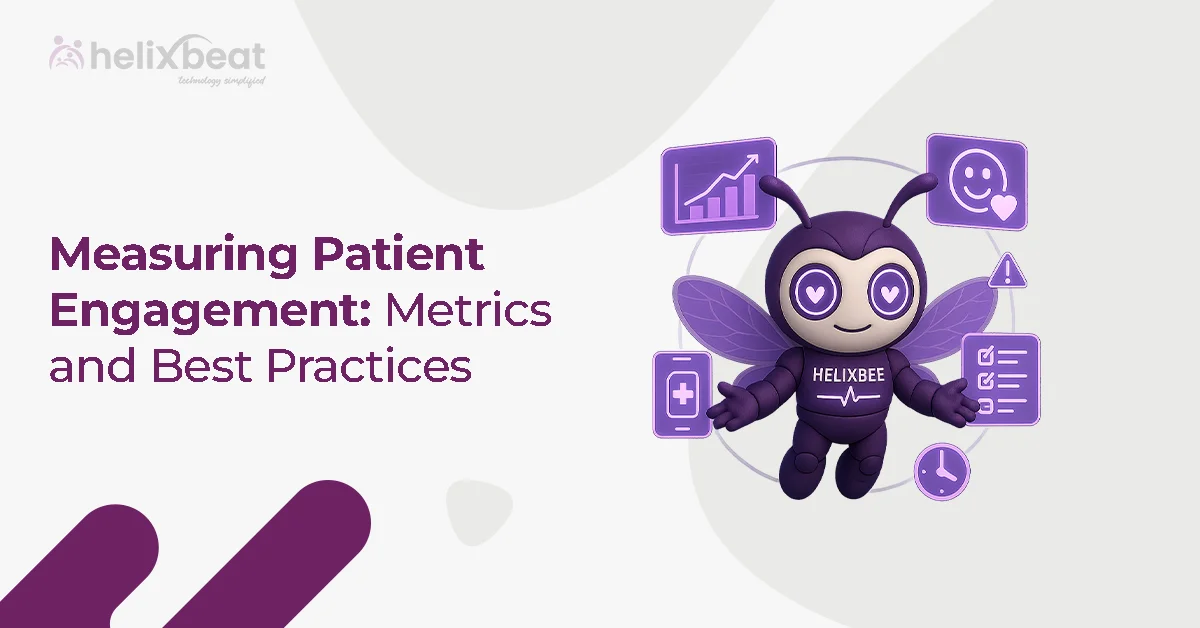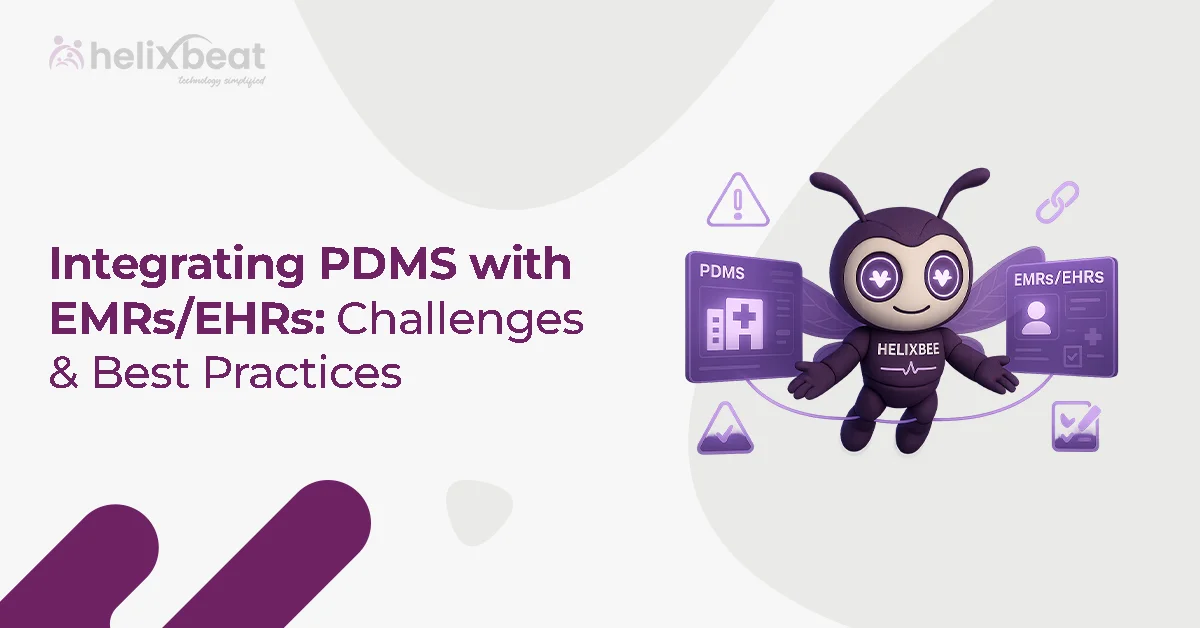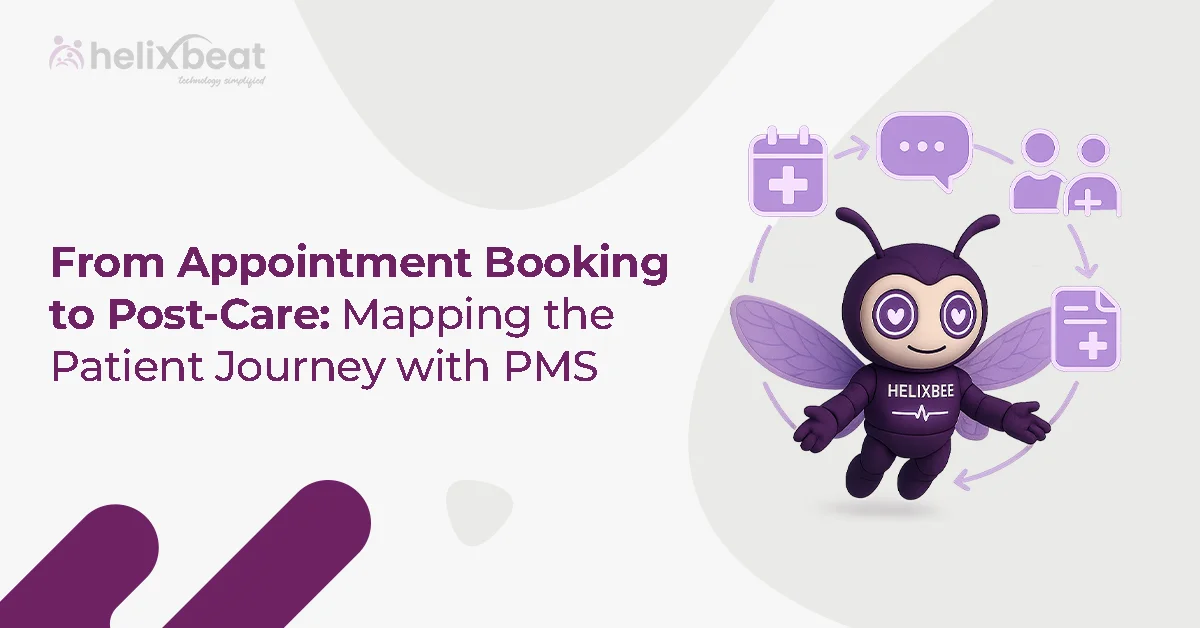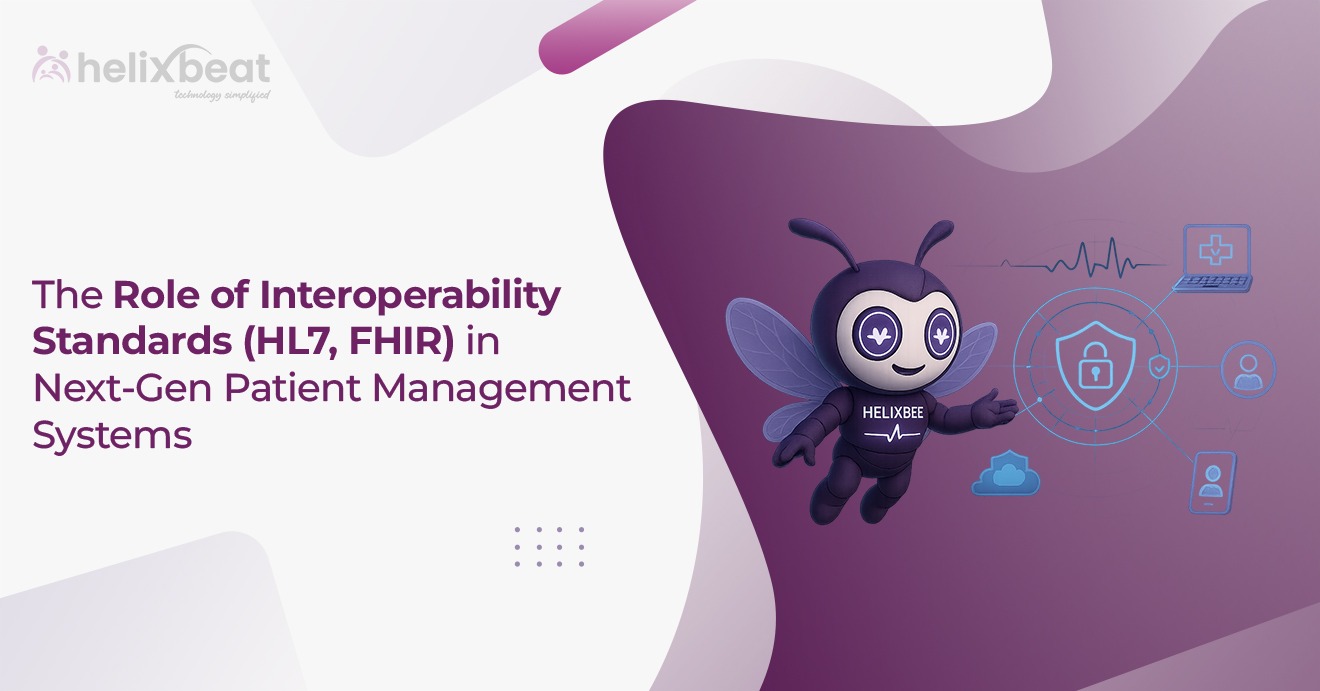Patient engagement plays a crucial role in enhancing outcomes, reducing hospitalizations, and fostering stronger relationships between patients and their providers. The Agency for Healthcare Research and Quality (AHRQ) notes that engaged patients are more likely to manage chronic conditions effectively and avoid unnecessary hospital visits.
Yet, many healthcare organizations still face challenges such as missed appointments, poor medication adherence, and low portal adoption. This is where patient engagement platforms like HelixBeat’s PULSE become essential. With secure messaging, automated reminders, and real-time dashboards, PULSE enables providers to track and improve engagement at every stage of the care journey.
In this blog, we’ll explore what patient engagement metrics are, why they matter, 12 essential KPIs to track, and best practices for leveraging digital solutions.
Table of Contents
What Are Patient Engagement Metrics?
Patient engagement metrics are the measurable indicators that demonstrate how actively patients participate in their own healthcare journey. These metrics help healthcare organizations go beyond assumptions and actually quantify patient involvement, whether that’s logging into a portal, attending scheduled appointments, responding to follow-up surveys, or adhering to a prescribed medication plan.
In simple terms, they act as a scorecard for patient involvement, giving providers a way to understand:
- How often do patients interact with digital tools like portals, apps, or chatbots?
- How well patients follow through on care plans, treatments, and preventive health measures.
- The level of satisfaction and loyalty that patients feel is reflected in surveys, feedback, and Net Promoter Scores (NPS).

Why does this matter?
Because patient engagement isn’t just about convenience, it has a direct impact on outcomes. For instance, research by the Agency for Healthcare Research and Quality (AHRQ) highlights that patients who are engaged in their care are more likely to manage chronic conditions effectively and less likely to need emergency interventions.
By consistently tracking patient engagement metrics, healthcare providers can:
- Spot gaps in communication or care delivery.
- Personalize interactions based on patient preferences.
- Measure the success of digital initiatives like apps, portals, or patient engagement platforms.
- Align performance with value-based care requirements.
In short, patient engagement metrics transform patient behavior into actionable insights, enabling providers to deliver better care, reduce costs, and foster stronger patient trust.
Key Components of a Patient Engagement Platform
A robust patient engagement platform is crucial for enhancing communication, streamlining workflows, and improving patient satisfaction. Here are the main parts that make a platform effective:
1. Personalized Communication
Effective patient engagement begins with personalization. By delivering targeted messages tailored to the patient’s unique health status, history, and preferences, providers can significantly enhance adherence to care plans. Personalized communication can include automated appointment reminders, custom educational content, or tailored treatment updates. This level of care creates a more connected and attentive healthcare experience for the patient.
2. Multi-Channel Access
Patients are diverse in their communication preferences, and a multi-channel approach ensures no patient is left behind. Whether through a mobile app, patient portal, text messages, or even email, offering various ways to access information increases the chances of engagement. By utilizing different channels, healthcare providers can communicate with patients on their terms, whether they are tech-savvy or prefer traditional methods. This flexibility also helps with the timely communication of essential health alerts or reminders.
3. Secure Messaging
Patient data security is paramount, and a secure messaging system ensures safe and confidential communication between patients and healthcare providers. It enables the exchange of sensitive information, such as lab results, medication changes, or care instructions, without compromising privacy. HIPAA-compliant messaging solutions ensure adherence to regulatory standards while providing a seamless communication experience for patients and healthcare providers. This fosters trust and builds stronger patient-provider relationships.
4. Analytics Dashboards
The true power of patient engagement lies in the ability to measure and improve. A comprehensive analytics dashboard provides real-time insights into patient behavior, engagement levels, and other key metrics. For example, healthcare providers can track how often patients use a portal, engage with educational content, or follow through with their appointments. These dashboards allow healthcare teams to identify patterns, make data-driven decisions, and address issues proactively.
5. Integration with Electronic Health Records (EHRs)
A well-rounded engagement platform seamlessly integrates with existing Electronic Health Records (EHRs). This integration ensures that all patient data is accessible in one place and that engagement strategies are based on up-to-date, accurate information. By connecting the patient’s engagement history with their medical records, healthcare providers can offer tailored experiences that not only improve engagement but also enhance care quality and reduce errors.
12 Metrics to Measure Patient Engagement in Healthcare Organizations
Tracking the right Key Performance Indicators (KPIs) is crucial for healthcare providers to assess the effectiveness of their patient engagement strategies. By monitoring these metrics, organizations can not only improve patient outcomes but also drive operational efficiency. Below are 12 essential metrics that help healthcare teams evaluate patient engagement in real time:
- Appointment Adherence Rate
This metric tracks the percentage of patients who attend their scheduled appointments. Low adherence rates can signal issues such as communication breakdowns, scheduling conflicts, or patient disengagement. Using tools like PULSE, providers can send timely reminders to patients, improving adherence rates and ensuring appointments are met.
- Patient Portal Usage
This refers to the frequency at which patients log into their online health portal, as well as their activity within the portal. High usage indicates active patient involvement in their healthcare, including scheduling, accessing test results, and communicating with their healthcare provider. Monitoring portal activity enables providers to assess how effectively patients are adopting digital tools for managing their health.
- Secure Messaging Adoption
Tracking how often patients use secure messaging to communicate with healthcare providers can help measure the effectiveness of digital communication channels. Secure messaging helps reduce unnecessary phone calls and in-person visits, improving efficiency while ensuring HIPAA compliance.
- Medication Adherence
This metric tracks how consistently patients follow their prescribed medication regimen, including refills and proper dosing. Medication adherence is crucial for achieving successful treatment outcomes, particularly in managing chronic conditions. Providers can use reminders and real-time alerts through digital tools to help patients stay on track.
- Preventive Care Participation
This involves monitoring patient participation in preventive healthcare measures, such as vaccinations, screenings, and wellness check-ups. Active engagement in preventive care enables the early detection of conditions and promotes healthier outcomes, ultimately reducing long-term healthcare costs.
- Health Literacy Scores
Measuring how well patients engage with educational content is an essential indicator of their understanding of health conditions and treatment plans. Through interactive tools such as quizzes, videos, and tailored resources, providers can assess and improve patients’ health literacy, which is crucial to treatment adherence and overall well-being.
- Satisfaction Survey Results
Feedback from patient satisfaction surveys provides insight into the quality of care and the overall experience patients have at healthcare facilities. This metric can identify areas needing improvement in both patient care and service delivery, such as wait times, communication quality, and provider interactions.
- Average Response Time
This metric tracks the speed at which healthcare providers respond to patient queries, whether through phone calls, emails, or secure messaging. A shorter response time indicates better engagement and shows that the provider values timely patient communication. It can directly influence patient satisfaction and trust in the provider.
- Remote Monitoring Compliance
With the rise of telehealth and wearable devices, it’s crucial to measure how well patients adhere to remote monitoring programs. This metric tracks patients’ compliance with using wearable health devices, such as fitness trackers or blood pressure monitors, which provide real-time health data to the provider for ongoing monitoring and intervention.
- Digital Tool Adoption Rate
This metric tracks the usage rate of digital health tools provided by the healthcare facility, including mobile apps, digital forms, and telehealth platforms. A high adoption rate indicates that patients are utilizing technology to actively manage their care, while low adoption rates suggest that additional education or system enhancements may be necessary.
- Net Promoter Score (NPS)
NPS measures patient loyalty and their likelihood to recommend the healthcare facility to others. This score is a direct reflection of patient satisfaction and engagement. A high NPS indicates that patients feel well cared for and are likely to engage with the provider in the future, while a low score highlights areas for improvement.
12. Treatment Plan Adherence
This tracks how well patients adhere to prescribed treatments, therapies, and exercises. Adherence to treatment plans is one of the most important indicators of successful patient outcomes, particularly for managing chronic conditions. Tools like PULSE can help providers send reminders and monitor progress, ensuring that patients stay on course with their care plans.
Traditional vs Digital Measurement Methods
Noite: Please create an infographic on the table below
| Metric | Traditional Method | Digital Method (PULSE) |
| Appointment Adherence | Manual record checks | Automated scheduling reports |
| Medication Adherence | Pharmacy phone calls | Real-time refill tracking |
| Patient Communication | In-person or phone only | Secure in-app messaging |
| Satisfaction Surveys | Paper-based post-visit surveys | Instant digital surveys & NPS |
| Preventive Care Participation | Manual data entry | Automated preventive care alerts |
Why Is It Important to Track Patient Engagement Key Performance Indicators?
Measuring patient engagement KPIs isn’t just about numbers—it’s about outcomes. Here’s why it matters:
- Improves Outcomes – Engaged patients are more likely to follow treatment plans and manage chronic conditions effectively.
- Reduces Costs – Non-adherence to medications alone costs the U.S. healthcare system hundreds of billions annually (CDC).
- Enhances Patient Experience – Personalized care improves satisfaction and loyalty.
- Supports Value-Based Care – Engagement metrics ensure providers align with outcome-based reimbursement models.
How to Use Dashboards to Monitor Patient Engagement Metrics?
A patient engagement software like PULSE comes with interactive dashboards that enable the visualization of trends and performance.
Key Dashboard Features:
- Real-time updates on patient activities.
- KPI comparisons across departments.
- Predictive analytics for early intervention.
- Integration with wearable and IoT devices.
Get a Free Demo of PULSE Today
Best Practices for Patient Engagement in Healthcare
Implementing patient engagement solutions like HelixBeat’s PULSE isn’t just about improving patient care; it also directly impacts the financial health of healthcare organizations. Here’s how:
1. Cost Reduction
By automating tasks such as appointment scheduling, reminders, patient communications, and data entry, PULSE frees up valuable resources, allowing staff to focus on higher-value activities. Additionally, reducing unnecessary phone calls and paper-based processes decreases the overall workload, leading to cost savings.
2. Retention Boost
Engagement isn’t just about attracting patients; it’s about keeping them. Engaged patients are more likely to return for follow-up care, which fosters long-term relationships and reduces patient attrition. PULSE’s personalized reminders, secure communication tools, and easy access to medical records help providers stay connected with their patients, ensuring they follow through with treatment plans, which results in higher retention and increased lifetime value.
3. Revenue Growth
Preventive care is a cornerstone of cost-effective healthcare. By engaging patients in preventive care activities through PULSE, including reminders for wellness exams, flu shots, and health screenings, healthcare providers can tap into these revenue streams. Furthermore, as patients become more proactive in their care, they are more likely to stay with the same provider, creating more opportunities for consistent billing and revenue generation.
4. Improved Clinical Outcomes Financial Benefits
Patient engagement directly contributes to better clinical outcomes. Research from Health Affairs suggests that patients who engage with their healthcare providers exhibit better treatment adherence, resulting in fewer hospital readmissions. Lower readmission rates help healthcare organizations avoid costly penalties under programs like the Hospital Readmissions Reduction Program (HRRP), leading to significant savings. Moreover, as engagement increases, patients are more likely to participate in disease management programs, which further reduces long-term care costs.
5. Enhanced Patient Satisfaction Competitive Advantage
Patients who feel involved in their healthcare are more likely to express higher levels of satisfaction, and satisfied patients tend to recommend providers to others. This word-of-mouth marketing and positive reviews translate into a higher patient acquisition rate and increased market share. The more connected and satisfied a patient is with their healthcare experience, the more likely they are to continue their relationship with the provider and refer others.
How Patient Engagement Solutions Drive ROI for Healthcare Providers
As patient engagement continues to evolve, healthcare organizations are increasingly turning to cutting-edge technologies to enhance their ability to deliver personalized, outcome-driven care. Here are the following major trends shaping digital patient engagement:
1. Predictive Analytics
The future of patient engagement will rely heavily on predictive analytics, which uses patient data to forecast future health risks and behavior patterns. By analyzing large datasets from patient interactions, medical history, and even wearable devices, healthcare providers can predict issues before they escalate.
For instance, predictive models can alert healthcare teams to patients at risk of missing an appointment or not adhering to a medication regimen, allowing for proactive intervention.
2. Virtual Health Coaching
Virtual health coaching is one of the fastest-growing innovations in digital patient engagement. AI-driven personal assistants can guide patients through wellness routines, encourage healthy habits, and provide real-time feedback on progress.
These systems can provide tailored advice, motivational support, and reminders to help patients manage chronic conditions such as diabetes or hypertension. A report by Accenture revealed that patients are willing to use AI to monitor their health, indicating the growing demand for digital health companions.
3. Continuous Health Data Tracking through Smart Devices
Wearable devices are already transforming how patients interact with their health data. The integration of wearables, such as fitness trackers, smartwatches, and ECG monitors, into the healthcare ecosystem is becoming increasingly common.
These devices continuously track key metrics, including heart rate, blood pressure, sleep patterns, and physical activity. With continuous data input, healthcare providers can adjust treatment plans in real-time based on data trends, improving patient outcomes.
4. Empowering Patients & Providers through PULSE
One of the most significant advancements in digital engagement is the use of real-time communication and analytics platforms, such as PULSE. This platform enables healthcare providers to engage patients proactively by tracking real-time data, such as appointment adherence, medication reminders, and follow-up care.
By integrating AI-driven analytics and secure messaging, PULSE helps providers identify at-risk patients, personalize care, and deliver relevant information directly to patients, all while ensuring privacy and compliance with healthcare regulations. Early adopters of platforms like PULSE have seen an increase in portal logins and a reduction in no-show appointments in the first year of use, demonstrating the tangible impact of real-time engagement on patient adherence and satisfaction.
Wrapping Up
Patient engagement is a measurable driver of both quality care and financial sustainability. Research from the Centers for Medicare & Medicaid Services (CMS) highlights patient engagement as a critical factor in achieving success under value-based care models.
By implementing a modern patient engagement software like PULSE, healthcare providers can systematically track critical metrics, such as appointment adherence, portal use, and messaging responsiveness, through intuitive dashboards. This empowers care teams to intervene earlier, improve adherence, elevate patient satisfaction, and reduce avoidable costs.
Ready to see measurable gains in engagement and outcomes?
Start Your Free Trial of PULSE
FAQs
- What are patient engagement metrics?
They are measurable indicators showing how actively patients participate in their care, such as appointment attendance or portal usage.
- Why is patient engagement critical in healthcare?
It improves patient outcomes, reduces unnecessary costs, and builds stronger trust between patients and providers.
- Which tools are used to track patient engagement?
Standard tools include patient engagement software, digital health apps, portals, and integrations with wearable devices.
- How can patient engagement software improve care quality?
It automates reminders, simplifies communication, and enables providers to track adherence in real-time.
- What are the challenges in digital patient engagement?
Key challenges include digital literacy gaps, accessibility issues, and integrating new tools with legacy systems.
- How do dashboards help monitor patient engagement?
Dashboards provide real-time data on patient activity, helping providers make faster, data-driven decisions.
- What role does personalization play in patient engagement?
Personalized communication and care plans increase adherence, satisfaction, and overall patient loyalty.
- Can patient engagement solutions integrate with EHRs?
Yes, advanced platforms like PULSE seamlessly integrate with EHR systems for unified data access.
- What KPIs should hospitals track for engagement?
Important KPIs include appointment adherence, medication compliance, patient portal usage, and NPS.
- How does PULSE differ from other patient engagement platforms?
PULSE offers AI-driven analytics, customizable dashboards, and multi-channel patient communication.
- What is the ROI of patient engagement software?
It reduces costs, improves patient retention, and increases revenue through preventive care.
- How does digital patient engagement improve patient satisfaction?
It makes care more accessible, timely, and convenient with digital touchpoints and secure communication.














